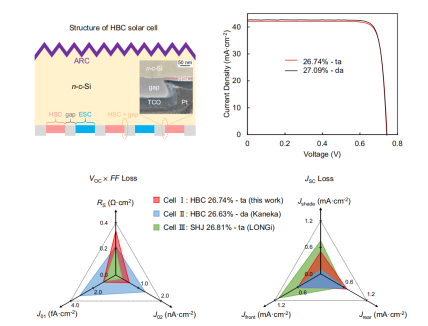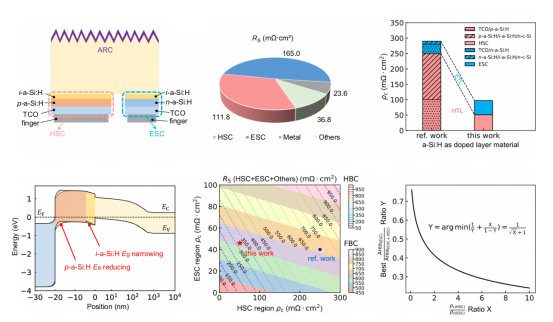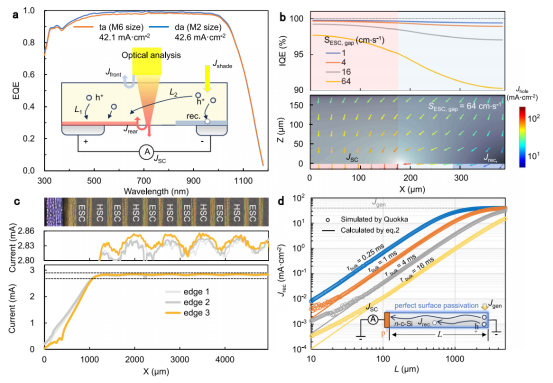
量子效率测试仪
PL/EL一体机
Sinton硅片少子寿命测试仪
Sinton硅块少子寿命测试仪
绒面反射率测试仪
3D共聚焦显微镜
清洗制绒工作站
在线四探针方阻测试仪
全自动扫描四探针方阻测试仪
在线薄膜厚度测试仪
晶化率测试仪
Horiba高速高分辨显微共焦拉曼光谱仪
傅里叶红外光谱仪
霍尔效应测试仪
分光光度计
全光谱椭偏仪
Horiba椭圆偏振光谱仪
TLM接触电阻率测试仪
超景深显微镜
网版智能影像测量仪
全自动影像测量仪
卧式拉力机
电池片稳态光衰老化试验箱
电池片紫外老化试验箱
电池片拉脱力综合测试仪
外观检验台
湿漏电测试系统
组件实验室EL测试仪
紫外老化试验箱
稳态光衰老化试验箱
电流连续性监测系统
PID测试系统
旁路二极管测试系统
LeTID测试系统
反向电流过载系统
脉冲电压测试系统
绝缘耐压测试仪
接地连续性测试仪
绝缘耐压接地测试仪
湿热环境试验箱
湿冻环境试验箱
热循环试验箱
动态机械载荷测试机
静态机械载荷测试机
冰雹冲击试验机
引出端强度试验机
霰弹冲击试验机
抗划伤(切割)测试机
剥离试验机
万能材料试验机(单臂)
万能材料试验机(双臂)
光伏玻璃透过率测试仪
醋酸测试试验箱
交联度测试系统
二极管接线盒综合测试仪
落球冲击试验机
半自动四探针
全自动探针式台阶仪
复合式LED模拟器
多通道太阳能MPPT系统
LED模拟器光浴
Horiba高灵敏一体式稳瞬态荧光光谱仪
钙钛矿P1激光划线测试仪
钙钛矿在线膜厚测试仪
钙钛矿工艺检测工作站
手持式IV测试仪
便携式EL测试仪
手持热成像测试仪
户外组件IV测试仪
户外组件多通道测试系统
光伏逆变器电能质量测试仪
无人机EL检测仪
HBC电池新突破!中山大学汪根顺博士最新NC:27.09%的高效异质结背接触太阳能电池
日期:2024-10-18浏览量:5
BC电池的发展降低了光伏发电的成本,但应用场景的多样化对电池技术提出了更高要求。研究发现 HBC 太阳能电池中接触电阻率对电池性能影响较大,如高接触电阻率会导致较高的串联电阻,进而降低电池的填充因子和功率转换效率。美能TLM接触电阻测试仪所具备接触电阻率测试功能,可实现快速、灵活、精准检测。
高效 HBC 太阳能电池

HBC电池的结构图、J-V曲线、电损失分析、JSC损失分析
通过优化电池结构和制造工艺,可以显著提高HBC太阳能电池的性能。特别是,通过减少重组损失和电阻损失,可以实现更高的电压(VOC)和填充因子(FF),从而提高电池的整体效率。此外,通过优化前表面的抗反射涂层和后表面的反射器,可以进一步提高电池的短路电流密度(JSC),进一步提升电池效率。

通过对比不同类型的太阳能电池(HBC 和 SHJ)在不同面积下的各项参数,可以看出不同结构和工艺对电池性能的影响。例如,在开路电压方面,不同电池由于材料和结构的差异有所不同;短路电流密度受到硅片厚度和测量面积等因素的影响;填充因子和功率转换效率则综合反映了电池的整体性能。
HBC太阳能电池的复合特性

晶硅被激光图案化为四个区域,分别为 HSC(空穴选择性接触)、ESC(电子选择性接触)、gap(间隙)以及 HSC + gap,通过对不同区域寿命曲线的对比,可以清晰地看出各区域复合特性的差异。这种差异为进一步分析复合电流密度在不同区域的贡献提供了依据,有助于确定哪些区域是复合的主要来源,从而为优化电池结构和工艺提供方向。
通过对不同区域能量带图、复合率及理想因子的分析,可以深入理解电池中不同区域的复合机制。这有助于针对性地采取措施来抑制复合,例如在 HSC 区域通过增强内置电场抑制复合,在极性边界区域通过管理边界形态减少复合。
HBC 太阳能电池的接触评估与设计

串联电阻(RS)的组成:
展示了HBC太阳能电池中串联电阻的组成,包括来自HSC(空穴选择性接触)堆叠、ESC(电子选择性接触)堆叠、金属电阻损失(从手指到汇流条)以及其他损失源(例如体电阻)。这些电阻损失的总和在电池的最大功率点(MPP)处对电池性能有显著影响。
HSC 和 ESC 区域接触电阻率优化分析:
接触电阻率测量:采用TLM测量法分别提取基于p-a-Si:H的 HSC 和基于n-a-Si:H的 ESC 的接触电阻率。结果显示 HSC 的接触电阻率为51.3mΩ·cm2,ESC 的接触电阻率为46.1mΩ·cm2。通过优化非晶硅(a-Si:H)层和掺杂纳米晶硅(nc-Si(Ox):H)层,可以降低接触电阻率,从而减少电阻损失。
在HBC太阳能电池设计中,接触电阻率和结构设计对电池性能的重要性。通过优化接触区域和调整HSC与ESC的覆盖面积比,可以显著降低串联电阻,从而提高电池的效率和填充因子。
HBC 太阳能电池电流损失的检测与分析

外部量子效率(EQE):da的EQE曲线在所有波长上都比ta高,表明JSC损失不是来自光学通道,而是来自重组。
电遮蔽现象的模拟:在不同表面复合率(SESC, gap)下,HSC区域的IQE接近100%,而ESC和gap区域的IQE较低,这是因为少数载流子需要更长的传输距离才能到达收集区域。
LBIC测量:显示了从HSC区域到电池边缘的LBIC强度的均匀下降。
重组电流密度与与有效寿命和传输长度的关系:模型说明了从右到左的设备中光生载流子(Jgen)的传输,它们被有效收集(JSC)或在路径上发生重组(Jrec)。
通过EQE谱、LBIC测量和模拟结果,详细分析了HBC太阳能电池中JSC损失的来源,特别是由于少数载流子在ESC和gap区域的较长传输长度导致的电遮蔽效应。分析结果对于优化电池结构设计、减少重组损失和提高电池性能具有重要意义。
HBC太阳能电池光电性能改进的策略

电气性能优化:
通过对比不同电池的这些参数,可以识别出提高电池性能的潜在途径,例如通过减少表面复合电流密度(J01和J02)和串联电阻(RS)来提升电池的开路电压(VOC)和填充因子(FF)。
光学性能优化:
这些参数分别代表前表面反射和寄生吸收损失、背面寄生吸收和逃逸反射损失以及电遮蔽损失。通过优化这些参数,可以提高电池的短路电流密度(JSC),从而提升整体的光电转换效率。
研究人员通过研究和分析,在制备HBC太阳能电池过程中取得的核心优化方向,并实现了27.09%的高光电转换效率。在高效HBC太阳能电池中,接触电阻率起着关键作用,主要是由于HSC或ESC区域的接触面积显著减少。通过优化HSC区域,研究人员实现了低于55 mΩ·cm²的最低接触电阻率。
美能TLM接触电阻率测试仪
联系电话:400 008 6690
美能TLM接触电阻测试仪所具备接触电阻率测试功能,可实现快速、灵活、精准检测。
n 静态测试重复性≤1%,动态测试重复性≤3%
n 线电阻测量精度可达5%或0.1Ω/cm
n 接触电阻率测试与线电阻测试随意切换
n 可定制多种探测头进行测量和分析
通过综合考虑电气和光学设计,以及对电池结构和制造工艺的精细优化,HBC太阳能电池的效率有潜力达到27.7%以上,这为未来太阳能电池技术的发展提供了明确的方向。美能TLM接触电阻测试仪具备高精度的接触电阻率和线电阻测试功能,测试范围广,重复性高。采用先进的(TLM)检测技术,尤显著提高测量精度和可靠性。
原文出处:Wang, G., Su, Q., Tang, H. et al. 27.09%-efficiency silicon heterojunction back contact solar cell and going beyond. Nat Commun 15, 8931 (2024). https://doi.org/10.1038/s41467-024-53275-5






































































